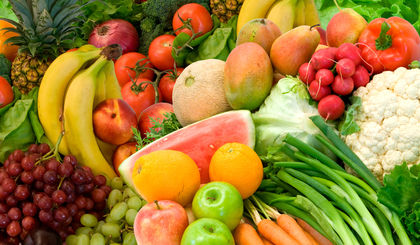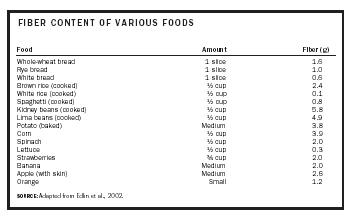Fiber

Fiber, which is found in all plant-based foods, is composed of a group of compounds that makes up the framework of plants. Although fiber cannot be digested, it is an essential nutrient for good health. The health benefits of a diet rich in fiber include lower cholesterol and a reduced risk of heart disease and certain cancers. Also referred to as roughage, fiber is made up of many compounds, mostly carbohydrates . It can be found in a variety of foods, including wheat, potatoes, and certain fruits and vegetables. Although the recommended amount of fiber is 20 to 35 grams a day, the average American consumes only 12 to 15 grams on a daily basis. Asians, on average, consume three times as much fiber as Americans do.
Types of Fiber
Complex carbohydrates, which are a major source of energy for the body, are comprised of two main classes: starch, which is digestible, and fiber, which is generally not digestible. There are also two kinds of fiber: insoluble and soluble. Insoluble fiber, found in wheat bran and some fruits and vegetables, cannot be dissolved in water. This type of fiber is made up of cellulose and hemicellulose, substances that offer rigidity to plant material (e.g., the peels and skins of fruits and vegetables, wood, stems, and the outer coverings of nuts, seeds, and grains). Insoluble fiber acts as a natural laxative, giving stool the bulk necessary to move quickly through the gastrointestinal tract. In addition to preventing constipation and hemorrhoids , insoluble fiber may also reduce the risk of colon cancer by speeding the passage of food through the digestive tract.
Soluble fiber, found in beans, oats, and some fruits and vegetables, is fiber that can be dissolved in water. This type of fiber is made up of pectins, gums, and mucilages. Marie Boyle notes that, because it reduces the level of cholesterol in the blood, soluble fiber can reduce the risks of heart and artery disease and atherosclerosis . When consumed in large amounts, soluble fiber also slows glucose absorption from the small intestine, which can be helpful in treating diabetes . Finally, a diet high in fiber may also promote weight control and reduce the risk of developing obesity .
How Much Fiber Is Necessary?
According to the American Dietetic Association, the daily goal for fiber intake is between 20 and 35 grams. However, the average intake in the United States is only 12 to 15 grams. In contrast, people in China consume as much as 77 grams of fiber per day. Children also need fiber, although in different

| Food | Amount | Fiber (g) |
| SOURCE: Adapted from Edlin et al., 2002. | ||
| Whole-wheat bread | 1 slice | 1.6 |
| Rye bread | 1 slice | 1.0 |
| White bread | 1 slice | 0.6 |
| Brown rice (cooked) | ½ cup | 2.4 |
| White rice (cooked) | ½ cup | 0.1 |
| Spaghetti (cooked) | ½ cup | 0.8 |
| Kidney beans (cooked) | ½ cup | 5.8 |
| Lima beans (cooked) | ½ cup | 4.9 |
| Potato (baked) | Medium | 3.8 |
| Corn | ½ cup | 3.9 |
| Spinach | ½ cup | 2.0 |
| Lettuce | ½ cup | 0.3 |
| Strawberries | ¾ cup | 2.0 |
| Banana | Medium | 2.0 |
| Apple (with skin) | Medium | 2.6 |
| Orange | Small | 1.2 |
amounts than adults. For children up to age 18, the recommended daily dose (in grams) is determined by adding five to a child's age. For example, a seven-year-old child would need 12 grams of fiber a day.
The recommended daily amount of fiber can be consumed by eating a diet high in fiber-rich fruits, vegetables, and whole grains. There are several ways to ensure one consumes enough fiber. First, it is important to read food labels. Although they do not distinguish between the two types of fiber, the labels of almost all foods will provide the amount of dietary fiber in each serving. Raw or slightly cooked vegetables will also provide an excellent source of fiber. However, overcooking vegetables may reduce the fiber content. Whole-grain cereals, whole-wheat bread, fresh or dried fruit, beans, rice, and salad are all good sources of fiber. The table presents the fiber content of various foods.
Problem with High-Fiber Diets
Including fiber in one's daily diet has definite benefits. However, although very uncommon, fiber has the potential to cause harm if taken in excess of 60 or 70 grams daily. "Since fiber carries water out of the body, taking too much can cause dehydration and intestinal discomfort or gas," (Boyle, p. 84). Large amounts of fiber require a high fluid intake. Therefore, as one increases fiber in the diet, water intake must also be increased. If one does not consume enough fluid, then one's stool could become very hard, resulting in difficult and painful elimination.
Fiber speeds the movement of foods through the digestive system. Since iron is mainly absorbed early during digestion, high amounts of fiber may limit the opportunity for the absorption of iron, calcium , and other nutrients. Finally, large amounts of fiber can also cause deficiencies of nutrients and energy by causing one to feel full before enough nutrients have been consumed. Children and elderly persons are especially vulnerable to these concerns, since they eat smaller portion sizes.
In conclusion, fiber is an important element of the diet and provides several health benefits. Eating balanced meals containing whole grain and fresh fruits and vegetables will ensure meeting the proper recommended allowances.
SEE ALSO Cancer ; Carbohydrates ; Heart Disease ; Nutrients .
Elissa M. Howard-Barr
Bibliography
Boyle, Marie, A. (2001). Personal Nutrition, 4th edition. Belmont, CA: Wadsworth/Thomson Learning.
Edlin, Gordon; Golanty, Eric; and McCormick Brown, Kelli, eds. (2002). Health and Wellness, 7th edition. Sudbury, MA: Jones and Bartlett.
Wardlaw, Gordon M. (2000). Contemporary Nutrition, Issues and Insights, 4th edition. Boston: McGraw Hill.
Internet Resources
American Dietetic Association. "Health Implications of Dietary Fiber—Position of ADA." Available from <http://www.eatright.com>
Food and Drug Administration. "Why Is Fiber Important to Your Diet?"Available from <http://www.cfsan.fda.gov>
Nutrition Newsletter (1997). "China Project Monograph Named China's Best Scientific Publication." Available from <http://www.nutrition.cornell.edu/news>

Comment about this article, ask questions, or add new information about this topic: